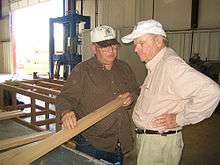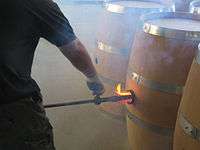A&K Cooperage
A&K Cooperage (also known as Artisan Barrels) is a Missouri-based oak barrel-making company, established in 1972. It is based in Higbee, Missouri.[1][2] They provide wine barrels to several notable companies, including Silver Oak Cellars, who purchased half of the company in 2000. They make white American oak barrels, air-dried between 18 and 36 months.


History


A&K Cooperage was established in Higbee, Missouri in 1972 as a keg business by D.L. Andrews and his son-in-law Dale Kirby.[3] They initially produced 5- to 20- gallon kegs but began concentrating on manufacturing 59-gallon American white oak barrels.[3] In 1988 they were involved in a court case and hired a New York attorney before they could collect $23,000 for a shipment of 200 barrels from a client who failed to make payment.[4]
Andrews died in 1996, leaving Dale Kirby and son, Matthew, to run the business. As a major supplier to Silver Oak Cellars, a top winery in northern California producing Cabernet Sauvignon, in 2000, A&K Cooperage formed an agreement with Silver Oak who bought out half the company.[3][5] They also purchased several hundred acres of timberland to maintain production.[3] Today the company produces about 3000 out of some 5000 barrels annually exclusively for Silver Oak.[3] In the 2000s, the company has aimed to expand its clientele to smaller and mid-sized wine producers, and since 2007 has used lasers to etch winery logos on the heads of the barrels they make.[3] The barrels have been used by several successful wineries who have won national and prestigious industry awards for their wines and have attributed A&K Cooperage in aiding the quality of their wines, including Silver Oak Cellars.[6][7]
Production
For over 25 years, A&K Cooperage has been producing 60 (59) gallon barrels, but they also make 30, 48, and 70 gallon barrels of both American and French oak.[8] They are made in the European tradition, treating the American oak wood with a process known as fire bending, toasted over an oak fire, which renders the wood more pliable.[3][8] The barrels are then air-dried for approximately 18 to 24 months, but up to 36 months.[3][9] The source of the oak is the forests in northern Missouri and Kentucky.[3] The barrels typically have eight galvanized hoops and can be free of char due to the mild slow burning process of barrel making.[10] Shipments are then sent to their clients, which in 1982 was stated to be with minimum orders of 25 barrels.[10]
References
| Wikimedia Commons has media related to A&K Cooperage. |
- Food & Beverage Market Place. Grey House Publishing. 2008. p. 61. Retrieved 27 March 2013.
- Secondary Wood Products Manufacturers Directory. Directory Department of Miller Freeman. 1989. p. 593. Retrieved 27 March 2013.
- "A&K Cooperage". Artisan Barrels. Retrieved 27 March 2013.
- The Wine Spectator. Wine Group. 1989. p. 1. Retrieved 27 March 2013.
- Jennings, Richard (6 June 2012). "Silver Oak: Reappraising a California Cabernet Icon". Huffington Post. Retrieved 27 March 2013.
- Vineyard & Winery Management. Vineyard & Winery Management. 1996. p. 31. Retrieved 27 March 2013.
- "Wine Review". Silver Oak Cellars. Retrieved 27 March 2013.
- "A&K Cooperage". Cooper's Oak Winery. Retrieved 27 March 2013.
- Practical Winery/vineyard. D. Neel. 2009. p. 76. Retrieved 27 March 2013.
- Practical Winery. Don Neel and Associates. 1982. p. 4. Retrieved 27 March 2013.